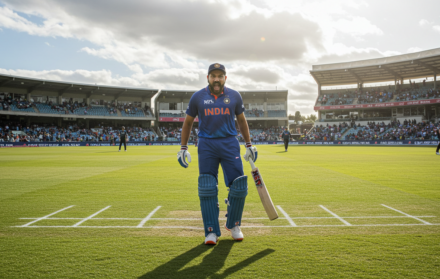
Sophie Ecclestone: England’s Spin Queen Taking Over T20 Cricket
Sophie Ecclestone’s dominance in T20 cricket is not born of deception, theatricality, or mystery. It is built on something far less romantic but far more effective: precision. In a format that favours the chaotic—ramp shots, switch hits, and ever-shortening attention spans—Ecclestone has quietly carved out her own method of control. While others look to outthink the batter with variation and risk, she applies pressure with relentless accuracy, a deep understanding of tempo, and the kind of calm rarely associated with high-stakes overs.
Her impact is not always packaged for television. There are no dramatic celebrations, no flamboyant appeals, no desperate theatrics. Yet the numbers remain unignorable: a consistently low economy rate, an ever-growing tally of wickets, and the trust of captains across every league she enters. What she brings is something teams cannot simulate in training—a bowler who removes momentum from a match not by shocking batters, but by restricting every option they might have considered a moment before.
This is not a tale of revolution. It is a study in application. Ecclestone’s rise is not that of the surprise prodigy or the reinvented veteran. It is the result of a deliberate, measured evolution—one that has turned her into the defining slow bowler of the fastest format in the game.
No Fuss, No Frills, Just Repetition and Reward

Sophie Ecclestone’s approach to spin bowling is striking precisely because it lacks the frills and flourishes so often celebrated in the modern short format. From her brief run-up to her high-arm action and tidy follow-through, everything about her style suggests clarity. She doesn’t bowl to entertain; she bowls to execute. Her control of length, ability to vary pace subtly, and the discipline to stick to her plan over long spells has made her one of the few spinners whose impact rarely relies on conditions. Whether on a dry pitch in Chennai or a flat track in Wellington, her consistency holds.
What sets her apart is not the delivery that turns square or the one that deceives in flight, but the patience to keep attacking a batter’s technique with marginal adjustments, over after over. Her success lies in how often she forces a batter to play the ball she wants them to, in the zone she has selected, on the terms she controls. While others in her position might respond to pressure with innovation, Ecclestone trusts her shape, her trajectory, and her game plan—traits more commonly associated with fast bowlers leading an attack than with a left-arm spinner.
From the outset of her international career, it became clear that England had found someone dependable, not just for containing runs, but for breaking stands through patience. She was given responsibility early, and not just token overs during quiet phases of a match. Whether opening the bowling or handling the middle overs, she was placed directly in the path of the opposition’s most dangerous players. And instead of retreating, she imposed herself quietly—through dot balls, through drawn-out overs, through removing intent.
It is that lack of compromise that has made her indispensable. As franchise cricket expands and national sides lean more heavily on defined roles, Ecclestone has become one of the few players whose place in the side is never up for debate. Her control is not only trusted, it is relied upon to shape match strategy. That level of influence is rarely achieved by spinners, and almost never maintained without dramatic reinvention. But in her case, it comes from consistency—measured improvement over time that makes her both predictable in method and incredibly difficult to counter in practice.
Pressure Phases and Tournament Temperament
Sophie Ecclestone’s most defining trait may not be her control, her accuracy, or even her tactical intelligence—it is her temperament. In a format that compresses pressure into every over and often hinges on the outcomes of a handful of deliveries, Ecclestone has developed a habit of making the hardest moments look routine. Whether asked to bowl in a Powerplay when fielding restrictions amplify risk, or trusted with a critical over at the death with margins down to single digits, she rarely strays from her plan. She does not overcomplicate. She does not overreact. She simply continues doing what she does best, at a time when others often lose clarity.
Her performances in major international tournaments have been a study in consistency. In the 2020 T20 World Cup, she finished as one of the most economical bowlers in the tournament, and again in 2022, her ability to stall scoring in middle overs became a key reason England remained competitive deep into the knockout stages. But beyond the statistics, what mattered most was how captains used her—not as a filler, but as the structural pivot in their attack. Her overs often reshaped game tempo, slowing things down enough for the team to regroup and strike elsewhere.
This influence is not accidental. Ecclestone’s clarity under pressure has made her one of the few bowlers in the world whose spell selection is driven by trust, not necessity. While many spinners are hidden from match-ups or avoided during power hitting phases, she is routinely called upon when other options have run out. Her overs are not just about control—they are about stability. And in a team sport that often relies on short bursts of brilliance, her calm execution across four overs brings a kind of strategic depth that makes every other bowler’s job easier.
The same qualities have translated across domestic leagues. Whether in the Women’s Premier League or The Hundred, she is treated not as a young spinner with upside, but as a senior player in the side’s bowling blueprint. Her economy remains tight. Her wickets come not in clumps, but at decisive junctures. Most importantly, her game doesn’t change when the stakes rise. In finals, eliminators, and high-attendance matches, she is rarely rattled. That is not a result of experience alone—it’s the product of a player who knows her strengths and applies them without concession.
Leadership Without Needing a Title

Although she does not wear the captain’s armband, Sophie Ecclestone has already begun to influence matches and teams in ways that extend beyond her own overs. Her understanding of batters’ tendencies, her communication with seamers about field angles, and her ability to adjust plans mid-over without needing external input have made her a central voice in both England’s bowling unit and her various franchise teams.
She is not a player who gestures theatrically or speaks for effect. But her field placements are often refined, her conversations with the wicketkeeper and captain purposeful, and her reads on batters remarkably accurate. That kind of match awareness often takes a decade to develop. In Ecclestone’s case, it emerged before she turned 25.
It is easy to underestimate how valuable this kind of leadership can be in modern T20 sides. In dressing rooms filled with specialist coaches and data analysts, on-field intelligence is still the most valuable currency during pressure overs. Ecclestone’s calm suggestions, subtle variations, and steady body language during tense phases give less experienced players a sense of order. That contribution rarely makes the broadcast. But it shows up in how sides respond when they are under threat.
This emerging leadership doesn’t necessarily suggest she is being groomed for captaincy, nor does she appear to chase it. Instead, she represents a different kind of leader—one who doesn’t command with speeches or status, but who alters the tone of a fielding unit through precision and steadiness. For a side like England, where young talent is being cycled into the setup and T20 strategy evolves with each series, her presence is quietly invaluable.
Navigating Expectation Without Needing to Reinvent
By the time Sophie Ecclestone was 23, she had already been crowned the world’s No. 1 ranked T20I bowler. For many athletes, that kind of early success becomes a difficult benchmark—one that fuels self-doubt or forces unnecessary change. Ecclestone, however, has treated the ranking not as a trophy but as a responsibility, continuing to perform at the highest level without allowing outside noise to dictate the shape of her game. While the cricketing world has evolved around her—more leagues, more games, more scrutiny—she has stayed remarkably close to the core method that made her effective in the first place.
What separates her from many other bowlers in her age bracket is the confidence to avoid change for its own sake. She does not need to add a carrom ball or a deceptive wrong’un to stay relevant. Her strength lies in her consistency and subtlety. She tweaks angles, not identities. Her grip remains classical, her release smooth, and her variations are small enough that they are difficult to spot, but large enough to alter outcomes.
In franchise cricket, where innovation is often rewarded more than repetition, Ecclestone’s restraint has been refreshing. She does not seek to bowl the most unplayable delivery of the night. She focuses on bowling a spell that anchors an innings, frustrates power hitters, and keeps her side in control of scoring phases that often spiral elsewhere. The result is not always a highlight reel, but a reliable shift in match tempo—one that coaches notice, captains trust, and opposition players quietly fear.
This approach is not just a matter of personality. It is a conscious decision to build longevity into her skillset. In a format where bowlers are frequently discarded after one poor season or shelved when variation becomes predictable, Ecclestone has created a style that is almost immune to trend. She is not relying on deception. She is relying on durability, and that allows her to perform on every surface, in every competition, against every calibre of batter.
Balancing the Spotlight with Simplicity

As one of the most marketable figures in the women’s game, Sophie Ecclestone now faces a different kind of pressure—the one that comes with visibility. Her face is on posters. Her name features in auction headlines. Her performance is dissected by pundits and replayed in highlight packages. Yet through this rise in attention, she has retained a personal style that resists theatrics. She does not court media headlines. She speaks plainly in interviews. She rarely frames her success as anything more than a job well done.
This refusal to amplify her own image has allowed her to remain grounded at a time when cricket is shifting into a hyper-professional, media-driven space. In an age of brand partnerships and public personas, Ecclestone’s quiet professionalism feels almost defiant. She has not distanced herself from the game’s growth—she plays every major league and contributes to the sport’s rising visibility—but she has not let that growth distort the way she operates on or off the field.
Her relationship with the spotlight is not indifferent, but pragmatic. She understands that being a world-class player means doing the media, meeting the commercial expectations, and carrying team responsibility. She just doesn’t let those obligations influence how she trains, how she bowls, or how she prepares. This clarity has been especially useful in her ability to stay level through form dips, injury scares, or team setbacks. She recovers not with reinvention, but with repetition—getting back to her action, her rhythm, and her role.
As women’s cricket enters a new phase—more formats, more fans, and more money—Ecclestone appears poised to remain central to the game’s evolution. Not by chasing reinvention, but by proving that excellence, when built properly, doesn’t need constant renovation. It just needs the discipline to stay grounded.
Setting the Standard for the Next Generation
In a sport that often recycles style and strategy across generations, Sophie Ecclestone has introduced a model of T20 spin bowling that feels genuinely original—not because it rewrites the fundamentals, but because it reasserts them with such quiet authority. For younger players coming through the ranks, particularly in England, she has become a template of what it looks like to succeed in modern T20s without sacrificing craft to spectacle.
Her method offers something rare for coaches and selectors: a reliable, replicable framework for development. She is not unorthodox in action or approach. Her technique is teachable. Her control is trainable. What cannot be replicated, however, is her composure—and it is this element, more than any technical strength, that has made her a reference point for young spinners hoping to find relevance in a batter-dominated era.
Beyond England, her presence in global leagues has normalised the idea of a frontline spinner being the central bowling figure in a team. She has shifted how captains structure their overs, how match-ups are constructed, and how left-arm spin is used under pressure. And she has done all of it without needing a dramatic breakout series or reinvented identity. Her influence has been cumulative, built through steady excellence across formats and continents.
There are louder role models in the game. There are more flamboyant talents. But for many aspiring bowlers, Ecclestone represents something more practical—and possibly more sustainable. She has shown that there is still room in modern cricket for bowlers who control matches with thought, rhythm, and repetition. In doing so, she has helped reshape the conversation around what it means to dominate in T20 cricket.
Sophie Ecclestone: Control as a Form of Power

Sophie Ecclestone’s rise to the top of T20 cricket has not been accompanied by reinvention, nor by loud proclamations about her place in the game. It has come through a sustained, deliberate process of doing the hard things well and doing them often. While the format continues to reward innovation, boundary hitting, and risk, her bowling proves that dominance can still come from the opposite direction—from discipline, predictability, and unwavering execution under pressure.
Her spells do not always light up highlight reels, but they often decide matches. Captains depend on her not just for wickets but for moments of stability. Teammates look to her for rhythm. Opponents plan for her weeks in advance and still leave with their plans undone. And through it all, she continues to bowl her overs with the same quiet confidence, the same calculated approach, and the same refusal to be rushed.
As the women’s game grows, both in visibility and commercial reach, Ecclestone stands as a model of what it looks like to succeed without distortion. Her game remains grounded in repeatable skills. Her influence grows without theatrics. And her consistency forces everyone else to adjust.
In a format designed to unravel bowlers, she has built a career defined by control—not just of line and length, but of tempo, of opposition intent, and increasingly, of the very shape of modern T20 cricket. She is not rewriting the rules of spin. She is proving that when the foundations are strong enough, they don’t need rewriting at all.





